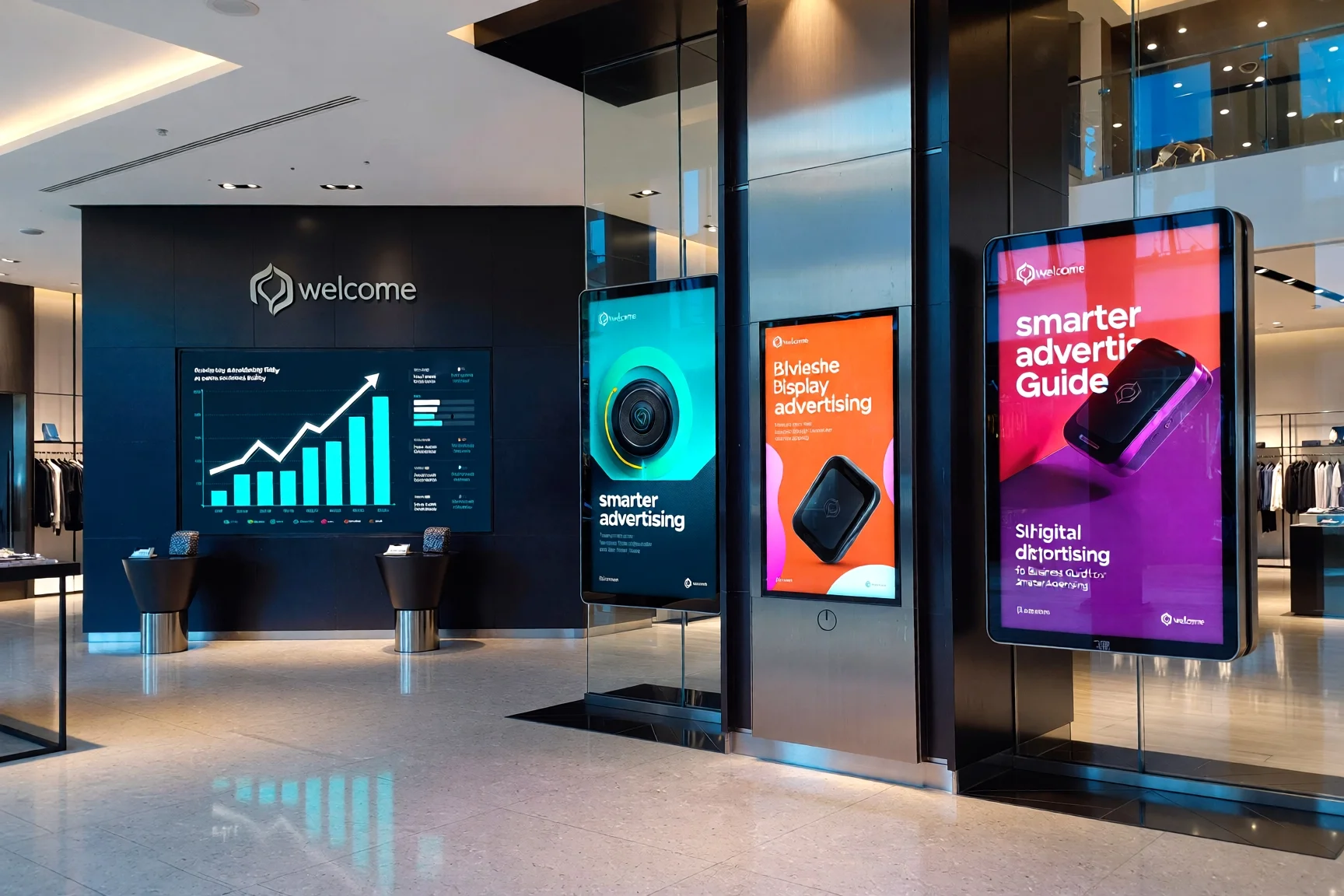The Shift from Static to Dynamic Business Communication
In the recent past, companies used posters, banners, and fixed signboards as the means of communication with their clients. In the current day, the static messages find it hard to keep pace with the dynamic demands of the contemporary consumer. Digital display boards for business have transformed this by introducing motion, versatility, and live control to the visual communication. Whether it be in the retail stores and restaurants or in offices and other places of prominent gathering, the screens have become louder than paper ever was.
A digital business display board is simply a screen that is dynamic and displays visual content (promotion, announcement, menu, or information) in an engaging and constantly changing manner. The businesses do not need to print, ship, and change physical signage each time there is a change in message.
Nento is leading this change and offering businesses effective digital advertising boards, smart software, and end-to-end signage solutions. This manual will take you through the varieties, advantages, software, and practical uses of digital display boards in growing your business with a lot of confidence.

What Are Digital Display Boards for Business?
Digital business display boards are the new business communication systems that can substitute the conventional printed signs with digital screens that are operated using software. These systems also enable businesses to update content in real time, automatically schedule campaigns, and display multimedia content like videos, animation, and live data feeds, unlike the use of the traditional signage approach.
Each digital display board system is based on three critical components. The first is the digital display board per se, which can be an LCD screen, an LED digital display board, or a large video wall. The second one is the media player, which is the engine that provides content to the screen. The third is the digital display board software, which is the control center where the content is created, scheduled, and controlled remotely.
These elements combine to create a flexible, centralized, and focused communication platform that helps the contemporary businesses. Digital display boards enable businesses to have complete control over what their audiences view and when they view it, whether the purpose is advertising, sharing of information, or brand storytelling.
Your screen becomes an always-on marketer that never takes a break.
Types of Digital Display Boards & Their Business Applications
The screen environment needed by various businesses varies, and hence there are various specialized digital display boards for business.
Indoor Digital Display Board
Most indoor digital display boards are located in reception areas, corporate offices, showrooms, and waiting rooms. They are perfect to greet visitors, provide the news of the company, and support the brand in the most visible areas.
Best use cases include hotel lobbies, corporate offices, healthcare waiting areas, and retail interiors.
Digital Menu Display Board
Electronic menu boards are transforming the manner in which restaurants interact with their clients. Menus can be updated in real time, promotions can be automatically executed based on the time of day, and visuals can be used to promote upselling without staff involvement.
Restaurants using dynamic menu boards report faster decisions and higher average order values.
Digital Video Display Board
Digital video display boards enhance immersive storytelling in high foot traffic areas like malls, trade shows, brand showrooms, and events. Strong emotional appeal and brand recognition are achieved through motion graphics and video content.
Outdoor Digital Display Board
The outdoor digital display boards are made in a bright, durable, and highly visible manner. They are placed at store fronts, drive-thrus, and open areas and work under extreme weather conditions and in direct sunlight; they remain very readable.
LED Digital Display Board
LED digital display boards are used both indoors and outdoors where high brightness and size visibility are needed. They are commonly applied in stadiums, shopping malls, and facades.
Digital Information Boards
Digital information boards facilitate real-time communication in spaces like hospitals, universities, transportation centers, and big corporate campuses. They give schedules, routes, notifications, and real-time operation information.
Find Your Perfect Display — Not sure which solution fits your space? Let Nento’s experts guide you. Book a Free Consultation.

Key Benefits of Digital Advertising Boards for Your Business
The digital advertising boards transform the nature of business-customer interaction. Improved customer interaction is among the most powerful benefits, since moving images are always attention-grabbing and will not cause fatigue of the message. As opposed to printed signage, the content is updated and reactive to real-world conditions.
Another significant advantage is sales agility. Companies are able to update the offers in real time, react to changes in stocks, and advertise time-limited offers without delays. This flexibility enables the marketing departments to experiment, optimize, and expand promotions on the fly.
Digital display boards also strengthen brand credibility as they portray a professional image that is modern. Concurrently, they save a lot of money on printing and material waste in the long term. Centralized control also increases efficiency in businesses, as it enables businesses to operate across multiple locations using a single dashboard.
One cloud dashboard. Hundreds of screens. Total control.
The Brain Behind the Screen: Digital Display Board Software
The software that is used to convert screens into intelligent communication tools is called digital display board software. An efficient platform has to be on the cloud, easy to use, and scalable.
Some major capabilities are remote content scheduling, automated playlists, and the possibility to launch campaigns in multiple zones on a screen at the same time. It must be compatible with social media feeds, real-time data feeds, and POS connections to support other environments like digital menu display boards. Multi-zone layout support enables companies to display multiple types of content on one display simultaneously.
The software created by Nento is a single convenient platform that integrates all these features in a user-friendly platform that can be used by both technical personnel and non-technical business professionals.
Try the Software Yourself—See how easy it is to manage your screens. Request a free demo of Nento’s software platform.
Planning Your Digital Signage Strategy: A Step-by-Step Guide
An effective digital signage plan starts with being able to define your business objectives. There are businesses that emphasize promotion and customer guidance, and many businesses tend to entertain or educate.
The second thing to do is determine where your audience spends most of their time, be it checkout counters, waiting bays, drive-thrus, or lobbies. The next step would be hardware selection that involves the selection of the appropriate display boards to use in business settings depending on size, brightness, and durability needs.
When software is chosen, all screens get linked into one network. After installation, businesses transition to content creation and scheduling and then continue with the performance tracking and optimization. Data-driven insights enable campaigns to evolve toward greater success.
Why Choose Nento for Your Digital Signage?
Nento is a full-solution digital signage partner and not merely a hardware or software supplier. Companies are provided with robust hardware that suits both indoor and outdoor settings with an easy-to-use software platform that does not need technical skills.
The integration of professional services, content design support, and expert systems makes sure that deployment is smooth on the very first day. Above all, Nento is scalable to any size of storefront, regardless of the number of locations of the brand.
From one screen to one thousand, Nento grows with your business.
Get Started Today—Ready to modernize your business communication? Get a free quote & system design from Nento.

Frequently Asked Questions (FAQs)
How much do digital display boards for business cost?
The prices depend on size, type, and software requirements. LED digital display boards are generally more expensive compared to standard LCDs. Nento offers customized price solutions that are scalable.
Can I manage the content myself easily?
Yes. The cloud-based digital display board software of Nento enables the use of non-technical people to update the content from any device.
What’s the difference between indoor and outdoor digital display boards?
Outside boards are brighter, weather-resistant, and temperature-resistant.
Can I integrate digital menu display boards with POS systems?
Yes. With POS integration, prices can be automatically updated, inventory can be synchronized in real-time, and manual errors can be minimized.
How long do digital advertising boards last?
With commercial-grade hardware, most displays last 50,000 or more hours, or several years of continuous operation.
Does Nento offer content creation services?
Yes. Nento offers professional designing services to enable business ventures to take off with high-impact visuals.
The Future of Business Communication is Digital
Digital advertising boards have become a core part of business communication in the modern world. They integrate the flexibility, visual appeal, and real-time control in one platform that enhances branding, better customer experience, and business growth that can be measured.
By choosing a full-solution partner like Nento, businesses gain more than screens and software—they gain a scalable digital ecosystem designed for long-term success.





